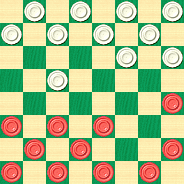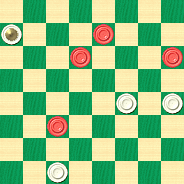The Checker Maven
Jump to navigationThe 11-Man Ballot Game

Most of us--- we're talking about the casual, average checkerist here--- are very happy with "Go As You Please" (GAYP) checker play, in which the choice of opening moves is completely at our own discretion. We find more than enough challenge and entertainment in this most basic form of our game.
But, as we're sure most of you know, at the highest levels of play, GAYP tends to be drawish, and games tend to repeat, especially when the players are unwilling to take risks with a championship or prize at stake. That's why "2-move restriction" and later on, "3-move restriction" checker play came into being. In these forms of the game, the first two or three moves are chosen at random, by "ballot," and a pair of games is played from the chosen ballot, each player trying his luck at each side of the opening. The idea is to force the game into different lines of play and avoid drawish repetition.
Of course, the reason that 3-move restriction arose is that 2-move restriction play was highly analyzed and drawishness crept into even this form of the game. 3-move restriction, which is today the common mode of play at major tournaments, does somewhat better, but it too has been analyzed a great deal.
There is another form of play, invented many years ago by champion Newell W. Banks, which provides literally thousands of possible opening combinations, far too many to easily analyze, and certainly too many to memorize. That form of play is called "11-man ballot." In this game, a ballot is chosen which eliminates at random one man from each side (hence the 11-man idea) and then chooses the opening move for each side, just as in 2-move restriction. There are some limitations and additional rules, but we're sure you get the idea.
11-man ballot hasn't been very widely played. There have been a few 11-man ballot matches and tournaments, but not very many. Only recently have we seen revived interest in this form of play, with 11-man ballot games and tournaments taking place at the GoldToken internet site, and a recent live contest held in North Carolina and won by Tim Laverty. A match championship is scheduled for summer 2008 between Tim and reigning 3-move world champion Alex Moiseyev.
11-man ballot makes for exciting and often unpredictable play, as unusual starting positions require the players to exercise their over-the-board skills to a very high degree. It has much to recommend it and we'll guess that 11-man ballot has a renewed and bright future.
Today, though, let's go back in time to the classic 11-man ballot title match between champions Asa Long and Newell Banks. Here's one of the better games from that historical match, which took place many years ago.
| Black: Asa Long |
| White: Newell W. Banks |
| Ballot pieces off squares 6 and 24 |
| Two Move Ballot---9-13, 23-19 |

BLACK
Starting Position; Black to Play
| 9-13 | 23-19---a | 11-15 | 28-24 |
| 8-11 | 26-23 | 5-9 | 22-18 |
| 15-22 | 25-18 | 11-15---b | 18-11 |
| 7-16 | 29-25 | 9-14 | 25-22 |
| 1-5 | 22-18 | 16-20 | 18-9 |
| 5-14 | 23-18---c | 14-23 | 27-18 |
| 20-27 | 31-24 | 3-7 | 18-14 |
| 10-17 | 21-14 | 4-8 | 14-9 |
| 8-11 | 9-5 | 13-17---d | 5-1 |
| 7-10 | 24-20 | 11-15 | 32-28 |
| 15-24 | 28-19 | 17-22 | 1-5 |
| 2-7 |

WHITE
White to Play and Win
W:W30,20,19,K5:B22,12,10,7.
Original notes are by Newell W. Banks.
a---Opens a beautiful position with the advantage to White, yet a sound defense seems possible.
b---Banks played 1-5 here against Long and should have drawn without much trouble.
c---Forms a magnificent ending which abounds with hidden possibilities.
d---7-10 looks best here and escapes with a narrow draw, thus 24-20, 11-15, 32-28, 15-24, 28-19, 20-16, 10-14, 6-1, 14-18, 1-6, 18-23, and Black just escapes.
Can you win the position shown above? Vote for your choice of move and then elect Read More to see the solution, the rest of the game, and additional explanatory notes.![]()
Solution
| 20-16---e | 10-14 | 5-9 | 14-18---f |
| 9-14 | 18-23 | 14-18 | 23-27 |
| 18-25 | 27-31 | 25-22 | 31-27 |
| 30-26---g | 27-31 | 26-23 | 31-27 |
| 23-18---h | 27-24 | 18-15 | 7-10 |
| 15-6 | 24-15 | 16-11 | 15-8 |
| 22-18---i | 8-11 | 6-2 | 11-16 |
| 18-15 | 16-20 | 15-19 | 20-16 |
| 19-24 | 16-20 | 24-28 | 20-16 |
| 28-32 | 16-19 | 32-27 | 19-16 |
| 2-6 | 16-19 | 6-10 | 12-16 |
| 10-14---1 |
e---Forms a most surprising "First Position" win.
f---14-17 would lose without much trouble as a short survey of the position will show.
g---The winning move and forms a neat problem.
h---The only move to win. 22-18 would allow a neat draw thus, 7-10. 16-11, 27-24, 18-15, then 12-16 draws.
i---Forces "First Position."
1---White wins; the First Position victory can't be avoided, for instance 19-15 27-24 16-19 24-27 15-11 14-18 11-7 18-15 is one attempt that just leads to a different loss. (Ed.).
Additional analysis and verification by the King's Row computer engine.
You can email the Webmaster with comments on this article.
